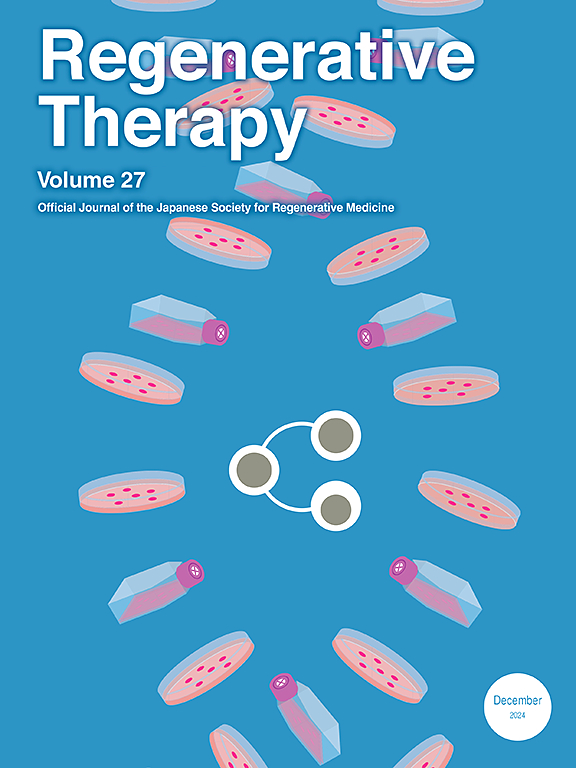胆管细胞来源的外泌体miR-381-3p通过靶向Klf6促进肝星状细胞活化和胆汁淤积性肝纤维化
IF 3.5
3区 环境科学与生态学
Q3 CELL & TISSUE ENGINEERING
引用次数: 0
摘要
肝星状细胞(hsc)的激活是推动慢性胆汁淤积性肝病(CCLD)进展的中心机制。MicroRNAs (miRNAs)在各种肝脏病理中的调节作用越来越得到人们的认可。本研究旨在鉴定参与CCLD进展的特异性mirna并阐明其潜在的分子机制。方法建立模拟胆汁淤积性肝损伤的小鼠胆管结扎模型。从小鼠大胆管细胞(MLE)中分离外泌体,并与造血干细胞共培养,研究其功能作用。采用逆转录定量聚合酶链反应(RT-qPCR)检测纤维化标记基因的表达水平。外泌体miRNA微阵列法筛选差异表达的miRNA。此外,我们进行了双荧光素酶报告基因检测和RNA下拉实验来验证miR-381-3p与其假定的靶基因——激酶蛋白家族成员6 (Klf6)之间的相互作用。结果成功分离了MLE外泌体。此外,BDL-MLE衍生的外泌体被证明可以促进hsc的激活并加剧肝纤维化。Dicer敲除降低了关键纤维化标志物的mRNA表达。此外,miR-381-3p在bdl - mle衍生的外泌体和转化生长因子(TGF)-β和bdl - mle外泌体处理的造血干细胞中均被发现上调。机制研究发现Klf6是miR-381-3p的直接靶基因。救援实验进一步发现,Klf6过表达可减轻miR-381-3p过表达引起的促纤维化作用,从而减弱HSC活化,减轻胆汁淤积性肝纤维化。结论本研究强调了mle来源的外泌体miR-381-3p通过调控Klf6促进HSC活化和胆汁淤积性肝纤维化的作用。这些发现为CCLD的分子机制提供了新的见解。本文章由计算机程序翻译,如有差异,请以英文原文为准。
Cholangiocyte-derived exosomal miR-381-3p promotes hepatic stellate cell activation and cholestatic liver fibrosis via targeting Klf6
Introduction
The activation of hepatic stellate cells (HSCs) is a central mechanism driving the progression of chronic cholestatic liver diseases (CCLD). MicroRNAs (miRNAs) have been increasingly recognized for their regulatory roles in various liver pathologies. This study aimed to identify specific miRNAs involved in the progression of CCLD and elucidate their underlying molecular mechanisms.
Methods
A bile duct ligation (BDL) mouse model was established to mimic cholestatic liver injury. Exosomes were isolated from mouse large cholangiocytes (MLE) and co-cultured with HSCs to investigate their functional effects. Reverse transcription quantitative polymerase chain reaction (RT-qPCR) was employed to assess the expression levels of fibrotic marker genes. Exosomal miRNA microarray assay was used to screen differentially expressed miRNAs. Furthermore, dual-luciferase reporter assays and RNA pull-down experiments were conducted to validate the interaction between miR-381-3p and its putative target gene, kinesin family member 6 (Klf6).
Results
The results confirmed the successful isolation of exosomes from MLE. Furthermore, exosomes derived from BDL-MLE were shown to promote the activation of HSCs and exacerbate hepatic fibrosis. Dicer knockout reduced the mRNA expression of key fibrotic markers. In addition, miR-381-3p was found to be upregulated both in BDL-MLE–derived exosomes and in HSCs treated with transforming growth factor (TGF)-β and BDL-MLE–exosomes. Mechanistic investigations identified Klf6 as a direct target gene of miR-381-3p. Rescue experiments further revealed that overexpression of Klf6 alleviated the pro-fibrotic effects caused by miR-381-3p overexpression, thereby attenuating HSC activation and mitigating cholestatic liver fibrosis.
Conclusion
This study highlighted the role of MLE-derived exosomal miR-381-3p in promoting HSC activation and cholestatic liver fibrosis through the regulation of Klf6. These findings provide novel insights into the molecular mechanisms underlying CCLD.
求助全文
通过发布文献求助,成功后即可免费获取论文全文。
去求助
来源期刊

Regenerative Therapy
Engineering-Biomedical Engineering
CiteScore
6.00
自引率
2.30%
发文量
106
审稿时长
49 days
期刊介绍:
Regenerative Therapy is the official peer-reviewed online journal of the Japanese Society for Regenerative Medicine.
Regenerative Therapy is a multidisciplinary journal that publishes original articles and reviews of basic research, clinical translation, industrial development, and regulatory issues focusing on stem cell biology, tissue engineering, and regenerative medicine.
 求助内容:
求助内容: 应助结果提醒方式:
应助结果提醒方式:


